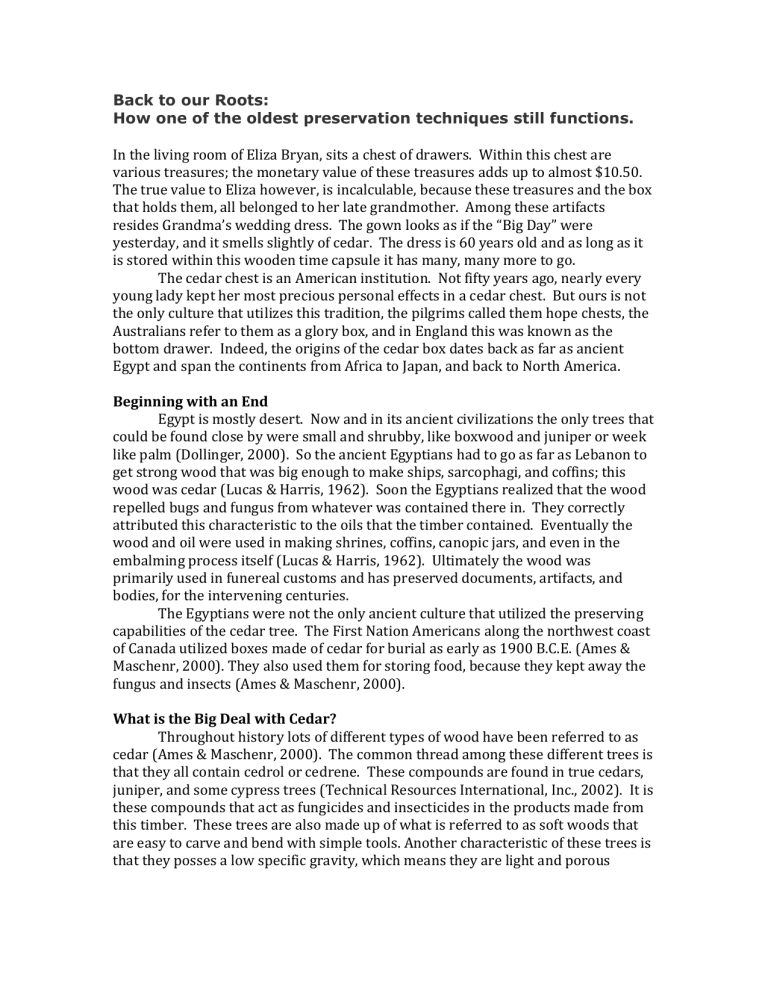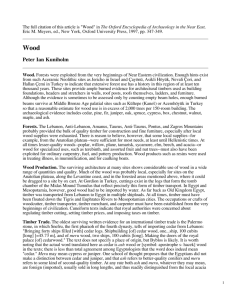Preservation Article - SLIM Portfolio: Sam Bryan

Back to our Roots:
How one of the oldest preservation techniques still functions.
In the living room of Eliza Bryan, sits a chest of drawers. Within this chest are various treasures; the monetary value of these treasures adds up to almost $10.50.
The true value to Eliza however, is incalculable, because these treasures and the box that holds them, all belonged to her late grandmother. Among these artifacts resides Grandma’s wedding dress. The gown looks as if the “Big Day” were yesterday, and it smells slightly of cedar. The dress is 60 years old and as long as it is stored within this wooden time capsule it has many, many more to go.
The cedar chest is an American institution. Not fifty years ago, nearly every young lady kept her most precious personal effects in a cedar chest. But ours is not the only culture that utilizes this tradition, the pilgrims called them hope chests, the
Australians refer to them as a glory box, and in England this was known as the bottom drawer. Indeed, the origins of the cedar box dates back as far as ancient
Egypt and span the continents from Africa to Japan, and back to North America.
Beginning with an End
Egypt is mostly desert. Now and in its ancient civilizations the only trees that could be found close by were small and shrubby, like boxwood and juniper or week like palm (Dollinger, 2000). So the ancient Egyptians had to go as far as Lebanon to get strong wood that was big enough to make ships, sarcophagi, and coffins; this wood was cedar (Lucas & Harris, 1962). Soon the Egyptians realized that the wood repelled bugs and fungus from whatever was contained there in. They correctly attributed this characteristic to the oils that the timber contained. Eventually the wood and oil were used in making shrines, coffins, canopic jars, and even in the embalming process itself (Lucas & Harris, 1962). Ultimately the wood was primarily used in funereal customs and has preserved documents, artifacts, and bodies, for the intervening centuries.
The Egyptians were not the only ancient culture that utilized the preserving capabilities of the cedar tree. The First Nation Americans along the northwest coast of Canada utilized boxes made of cedar for burial as early as 1900 B.C.E. (Ames &
Maschenr, 2000). They also used them for storing food, because they kept away the fungus and insects (Ames & Maschenr, 2000).
What is the Big Deal with Cedar?
Throughout history lots of different types of wood have been referred to as cedar (Ames & Maschenr, 2000). The common thread among these different trees is that they all contain cedrol or cedrene. These compounds are found in true cedars, juniper, and some cypress trees (Technical Resources International, Inc., 2002). It is these compounds that act as fungicides and insecticides in the products made from this timber. These trees are also made up of what is referred to as soft woods that are easy to carve and bend with simple tools. Another characteristic of these trees is that they posses a low specific gravity, which means they are light and porous
(Hioki, 2007). This unique attribute lets the wood regulate the relative humidity and temperature of the contents.
Preserving the Past for the Future
All these characteristics have made it possible for cedar wood to protect the past. It helped the ancient Egyptians, and the First Nation Americans. It has preserved Eliza’s grandmother’s wedding dress, and it is still preserving some of
Japan’s most treasured artifacts (Hioki, 2007). In Nara, Japan, the Shosoin Treasure
House was built in the 8 th century. This building, which is still in excellent condition, housed approximately 9000 items. The treasure house is built entirely of Japanese
Cypress (Hioki, 2007). Not only is the building made of this cedar type wood but the boxes that contain the artifacts themselves are made of Japanese cedar. In these cases the treasures were protected from bugs, fungus, sudden changes in temperature. They even temper the changes in relative humidity, which are common in this area, and can be extremely detrimental to documents especially.
The Shosoin Treasure House kept these artifacts in near perfect condition for 1200 years (Hioki, 2007). The design works so well, in fact, that when the Archives of the
Imperial Household Agency was building its new storage facility, it opted to create an HVAC system based entirely on the treasure house. So, not only are the precious documents they store there well protected, but also the cost of maintaining the building is drastically reduced because it is almost entirely naturally ventilated.
The cedar trees of Lebanon are among the oldest living organisms on the face of the earth. These trees contain secrets of preservation that man has been using since before the pyramids of Egypt and will be using for the foreseeable future.
Whether it be the most important documents in the Japanese Empire or the bridal gown of Eliza’s grandmother, cedar protects the past in one of the oldest and simplest forms possible, a wooden box.
Works Cited
Ames, K. M., & Maschenr, H. D. (2000). Peoples of the Northwest Coast: Their
Archaeology and Prehistory. London: Thames and Hudson.
Dollinger, A. (2000, August). Wood. Retrieved July 28, 2012, from An introduction to the history and culture of Pharaonic Egypt: http://www.reshafim.org.il/ad/egypt/timelines/topics/wood.htm
Hioki, K. (2007). From Japanese Tradition: Is Kura a Model for a Sustainable
Preservation Environment? From Gray Areas to Green Areas: Developing Sustainable
Practices in Preservation Environments. Austin: The Kilgarlin Center for Preservation of the Cultural Record.
Lucas, A., & Harris, J. (1962). Ancient Egyptian Materials and Industries (4th Edition ed.). London: Dover Publications.
Technical Resources International, Inc. (2002). SUMMARY OF DATA FOR CHEMICAL
SELECTION. Retrieved July 20, 2012, from National Toxicoligy Program: http://ntp.niehs.nih.gov/ntp/htdocs/Chem_Background/ExSumPdf/cedarwood_oil.









